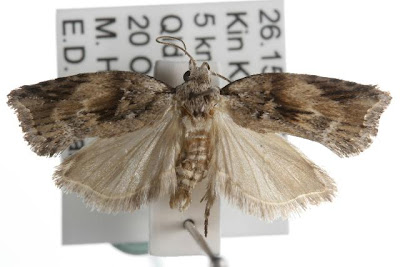Lichenaula phloeochroa Turner, 1898
BOLD
ANIC
Lichenaula phloeochroa Turner, 1898. The Xyloryctidae of Queensland. Annals of the Queensland Museum 4: 1–32 [18]. Syntype(s) ANIC 2♂, Brisbane, Qld.
Lichenaula phloeochroa Turner, 1898 = syn L. provisa T.P. Lucas. Common, in Nielsen, Edwards, & Rangsi, 1996, Checklist of the Lepidoptera of Australia. Monographs on Australian Lepidoptera, 4: i-xiv, 1-529 & CD-ROM [88].
Xylorycta phloeochroa (Turner, 1898). Beccaloni, G. W., Scoble, M. J., Robinson, G. S. & Pitkin, B. (Editors). 2003. The Global Lepidoptera Names Index (LepIndex). World Wide Web electronic publication. http://www.nhm.ac.uk/entomology/lepindex [accessed 23 April 2010].
Lichenaula phloeochroa Turner, 1898. Edwards, E. D. (2003), Xyloryctinae. Australian Faunal Directory. Australian Biological Resources Study, Canberra. http://www.environment.gov.au/biodiversity/abrs/online-resources/fauna/afd/taxa/XYLORYCTINAE [accessed 18 June 2010].
Original description, Turner 1898
Lichenaula phloeochroa, n .sp. Male, 19-24 mm. antennal ciliations, 2/3. Forewings with vein 7 to hindmargin. Head and face whitish. Palpi whitish, apical 1/3 of terminal joint fuscous. Antennae whitish. Thorax whitish. Abdomen ochreous-whitish. Legs whitish; anterior tibiae fuscous internally, anterior tarsi annulated with fuscous. Forewings oblong, dilated posteriorly, costa moderately arched, apex round-pointed, hindmargin slightly sinuate before apex, obliquely rounded; whitish; the veins partly outlined by blackish fuscous scales; basal part of disc sparsely irrorated with fuscous; a pale reddish-brown suffusion over middle and posterior portions of disc. above fold; several inconspicuous black dots on apical 1/3 of costa; cilia whitish irrorated with fuscous scales. Hindwings pale grey; cilia whitish.
Brisbane: two specimens from larvae found in stems of Melaleuca leucadendron (Tea-tree), emerging in November.
Diagnosis:
Description:
Head:
Thorax:
Abdomen:
Food plants: Larva boring in stem. Larval foodplant: Melaleuca leucadendra (Myrtaceae). (Edwards, 2003).
Flight period: November.
Distribution: New South Wales, Queensland. Endemic. (Edwards, 2003).
Remarks: Barcoding has shown this species to be distinct from L. provisa, removing the synonymy proposed by Common. L. provisa is listed as a separate species.

